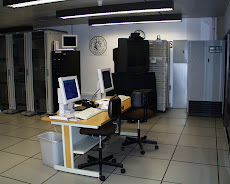OK. So you are working on getting a new storage system. If you're an EMC shop, you can do a self install of the CX4, and possibly save yourself a bunch of $$. Why do a self install? Well aside from the $$ savings, its easy, and you can do it way faster then EMC can coordinate and schedule an installation SE/CE.
A CX4 consists of a SPS, SPE, and multiple DAE's. The SPS is standby power supply that sits at the bottom and powers the SPE and the first DAE. The SPE or "Storage Processor Enclosure" contain two processors or SP's called SPA and SPB. Basically two storage processors to run the array. They are independent and if one fails, the other one continues to run the Array. It is very rare to have a multi-SP failure. It can happen, and would be more likely a bug, but its not likely. That is what makes the Clariions so reliable. They run and run and run. The last thing is the DAE or "Disk Array Enclosure". This holds all the drives. One of the DAE's you will receive is special in that it contains "Vault Drives" and vault drives contain the OS the Clariion boots from. This needs to be the first DAE attached to the SPE.
The EMC install guide is very good and if you follow it, you'll have a basic CX4 running in a few hours. So working from the bottom up. You'll get the following installed
- SPS. Install this on the bottom. If its in a cabinet, leave 1U space on the bottom. But an airflow cover over the space on the front if you have one. If you ever need to replace an SPS, you will need the space, or its a ?itch to replace in a fully loaded cabinet.
- SPE. On top of the SPS, install the SPE.
- DAE. On top of the SPE, install the DAE containing the vault drives.
- DAE - The Rest of them. Install the rest of the DAE's.
SPA/B and Backend CablingThe backend cabling is the first cable job. Depending on the CX4 model, you will have either 1, 2, or 4 backend ports. A CX4-120 has one, a CX4-240 has 2, A CX4-480 had 4. Get it?
1st DAE. Now follow the install guide and start with SPA. Take the appropriate cable (SFP to HSSCD2 Cable) and plug it into the slot 0, port 0 on SPA and the other end to the corresponding primary port (PRI) on the 1st DAE. Be sure this DAE has the specially marked "array software" label across the 1st five disks. Then do the same for SPB
2nd DAE. Connect slot 0, port 1 on each SP to the 2nd DAE. Stop at the 2nd DAE for now. You should have the SPS, SPE, and two DAE's cabled. That is good to start. Be sure to review step 1 in the install guide and ensure the cabling is right. This is the hardest part. If its not, the SP's can not locate the vault drives and they will not boot.
Power is Next - To Equipment that is.
The next thing is to get the power cables installed. Be sure the SPS's are off. Its best to use a separate power source to each SP. i.e. Do not run from the same PDU. Put them on separate PDU's, breakers, etc. You will see that their is really two SPS's and they fit in a single tray. One SPS powers each SP. So once you have power to the SPS right under SPA, you will run a power cable from the SPS to SPA. Then another from the SPS to the power on the 1st DAE. Once you do this, you do the same for the other SPS and SPB and DAE. Once you have the SPS powering the SPE and 1st DAE, go a head and run another set of power cables from your PDU to the 2nd DAE. Once you do that, the 2nd DAE will power up and that is ok. The SPS should still be turned off and both the 1st DAE and SPE will be off. That is what we want.
There is also a SPS serial cable. One end plugs into the SPS and the other end plugs into the SPE. And there are two. One for each SP. In the install quide its got a picture and it is self explanatory.
Apply power and boot it up. Flip on each SPS. Remove the front bezel's and there are two lights for the SP. They flash during boot then go off. The bad light is the blinking yellow light. That tells you there is a fault. If any of your backend is wrong, that is likely the cause of the fault. Reexamine your cabling. It's usually a calbe that causes it to fail and not boot.
Did it boot? It should have. Look on the back. Thers is a light above each model. There is a management model, backend module, and iscsi module. You really want the mgmt and backend modules to be green. If not, back to the cable. Review it. It's likely wrong. If it is. Go ahead and shutdown the Array by turning off each SPS and waiting for it to shutdown the Array. It can take 2-3 minutes. Then fix the cables and start it back up. Once it comes up and all the yellow lights are out and the rest are green, then your ready to initalize it.
Recommended ReadingEMC Clariion CX4-240 Setup Guide (Requires Powerlink Access - You have that? Right!). This has all info needed to setup. Diagrams, pictures, etc. Just take your time. It is not very hard. Concentrate on the cabling and you will have no problem getting the physical installation going.
Next Steps. I'll post info on initializing the Array and how to troubleshoot.

